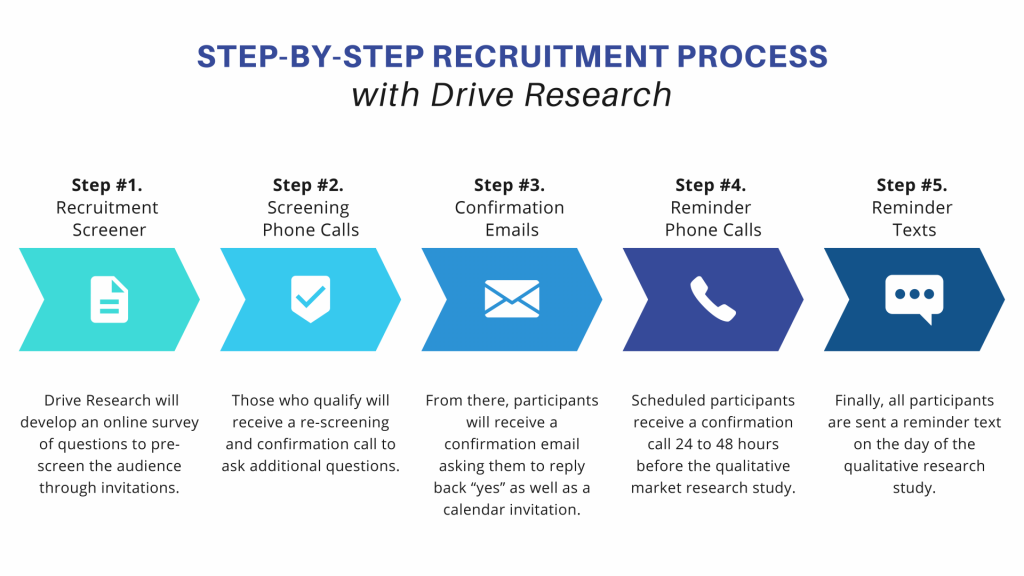
The process to recruit for focus groups is similar to many other types of qualitative market research.
Whether it is a focus group, an online bulletin board, or an in-depth interview (IDI) by phone, qualitative research describes exploratory methodologies that explore the mindsets, perceptions, and decision-making processes of participants.
However, these projects are only as good as the people you find to participate in them.
In this blog post, our market research recruitment agency details the step-by-step process to successfully recruit quality participants for a qualitative group discussion.
For more detailed information, I recommend reading our Ultimate Guide to Recruiting Participants for Qualitative Research.
Step #1: Determine How to Reach Your Audience
The first question you have to ask yourself is, “Where do target participants spend their time?”
If 90% of your customer base or targeted participant prefers to talk over the phone, is email a good option for you to recruit? Probably not.
The same holds true on the opposite end. Who answers the phone anymore, right? Particularly if it is a number you don’t recognize.
This trend has driven a collapse in the success of phone surveys and traditional recruitment call centers.
With this approach to recruiting for focus groups, it can take weeks or even months to find quality participants.
For this reason, our focus group company often recommends utilizing online recruitment methods instead. But more on that later!
There are a few demographics of people who however are not on social media or even have an email. In this regard, considering mail surveys or phone surveys may be the best option.
Step #2: Determine Your Screening Criteria
After you have identified how you plan to contact your potential participants, the next step is designing a recruitment screener that qualifies or disqualifies people for the study.
It often includes demographic survey questions to determine if someone matches your criteria for joining the in-person or online focus group.
Example of Using a Recruitment Screener for Focus Groups
Let’s say you are completing an alcoholic beverage study there are several must-have screener questions.
For example, one of the first questions might be “Are you above the age of 21 to start?” If someone is under 21, you would disqualify the participant.
You also want to screen them to make sure they drink alcohol, correct?
Other screener criteria may include a mix of alcoholic beverages drank, a mix of ethnicities, a mix of age groups, etc.
In short, your screening criteria help guide the efforts set forth by the qualitative recruitment company.
Step #3. Program Your Survey
After you have the screener document finalized, your next step is to program it.
The programmed version can be used for computer-assisted telephone interviewing (CATI) if you are using a call center to contact and recruit participants.
It can also be used for any online recruitment you conduct through email or social media.
The benefit of programming the screener online or through CATI is that it handles skip patterns and routing logic for your survey. In doing so, the respondent is only asked pertinent questions.
Going back to the example above, if they do not drink light beer, they will not be asked how many times per week they drink light beer.
Interested in learning more programming tips and tricks? Here are 4 Tips to Program Your Survey.
Step #4: Send Your Focus Group Recruitment Invites
Now that your plan is finalized, your questions are structured, and your screener is programmed, the next step is to jump into qualitative recruitment.
Here you will work with your qualitative recruiting company, like Drive Research, to begin qualifying and signing up participants for the market research.
In most cases, the recruitment firm will source participants in one of two ways:
- Using a third-party market research panel
- Using social media
Using a third-party market research panel
There are many benefits to using a third-party panel – especially when recruiting for focus groups.
For instance, these participants were likely participants from past market research studies and have already indicated an interest in participating in future market research.
Our panel recruitment efforts at Drive Research are continual. Our market research company is always searching for new participants across the country to join our panel.
This helps us keep costs down for our clients by having a pool of participants to pull from.
Using social media
Does your targeted participant base spend a lot of time and remain active on social media? Don’t we all?
Facebook, Twitter, and Instagram might be options to recruit B2C participants.
Are you in the B2B space? That’s okay. LinkedIn is a great resource as well.
You’ll also want to consider B2B recruiting on Facebook as well. Many users share their place of employment and titles so it’s easy to target audiences there.
Before turning to social media, watch this 60-second video for common best practices, or read our [Ultimate Guide] How to Use Social Media to Find Research Participants.
Step #5: Place Confirmation Calls, Emails, and Texts
Even after you have your participants recruited and qualified, the work for the qualitative recruitment company is not done quite yet.
Each participant still needs to be followed up with to confirm interest and obtain a commitment to participate in the focus group, interview, or other forms of market research.
Our standard process may seem like it’s overload but it’s absolutely necessary to make sure our clients get the highest possible participation rates.
This includes a confirmation phone call after the participant is chosen for the focus group or qualitative research.
This is followed by a confirmation email or confirmation letter mailed to their household.
Finally, we like to place a final reminder call 48 hours before the focus group or interview and a reminder text hours before it begins.

How Many People Should You Recruit for Focus Groups?
The number of people you should recruit for a focus group depends on various factors, such as the purpose of the research, the location of the facility, and the feasibility of recruiting your target audience.
However, a general rule of thumb is to recruit between 6 to 10 participants for a focus group.
On one hand, having too few participants may not provide enough diversity of perspectives and may not allow for a comprehensive exploration of the topic.
But, having too many participants can make it difficult to manage the discussion and ensure everyone has an opportunity to speak.
What Types of People Are Good Candidates to Recruit for Focus Groups?
The qualities of good candidates for focus groups depend on the specific research or business objectives of the study.
Generally, it’s important to recruit individuals who are closely aligned with your target audience.
For instance, if a brand is conducting focus groups for new product development market research, then it would benefit the brand to recruit participants who match the demographics of their target buyer.
Here are some factors to consider when selecting participants:
- Demographic characteristics: Depending on the research goals, it may be important to recruit focus group participants who represent a particular demographic group, such as age, gender, ethnicity, education level, or socioeconomic status.
- Behavior or usage: If the focus group is related to a product or service, it may be beneficial to recruit participants who use or have used similar products or services in the past, or who have behaviors that relate to the topic being discussed.
- Geographic location: If the focus group is related to a specific geographic location, it may be beneficial to recruit participants who are from that area or who have experience living or working in that area. For instance, our Syracuse focus group facility.
- Open to offering feedback: It’s also important to ensure that the participants in the focus group are willing and able to participate in the discussion, and are comfortable sharing their thoughts and opinions in a group setting.
Contact Our Qualitative Research Recruitment Agency
Companies and organizations often work with qualitative recruitment agencies, like Drive Research to qualify and secure participants for their upcoming research studies.
These qualitative recruitment firms often have the expertise and proprietary lists of panel members to make the recruitment process run smoothly and cost-effectively. All while obtaining high-quality respondents for the market research.
Drive Research is a national qualitative recruitment firm. We specialize in quality and timely focus group recruiting, research interview recruiting, website usability recruiting, and other forms of market research recruitment.
Need participants for your qualitative market research? Contact our focus group recruitment company today.



